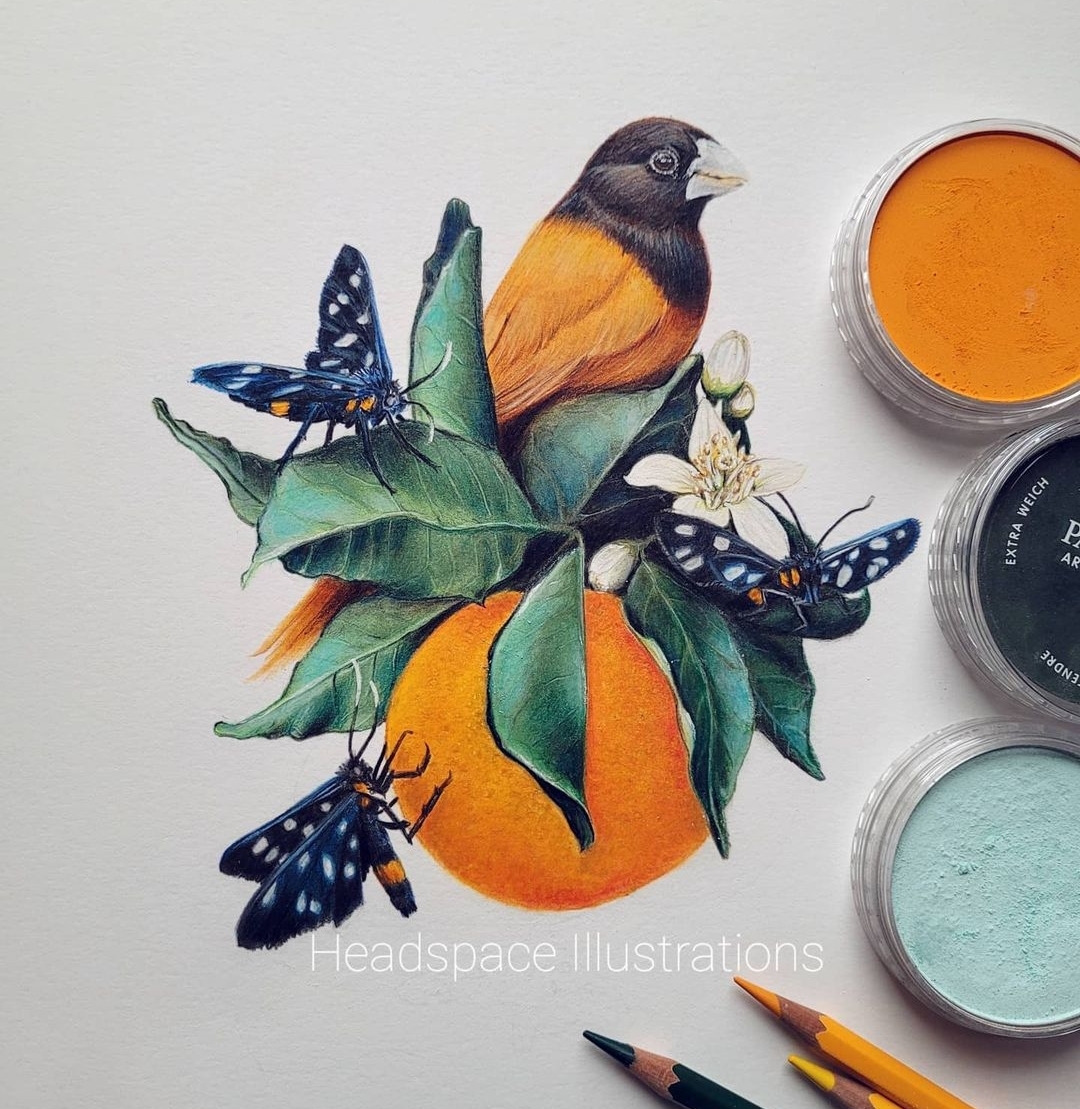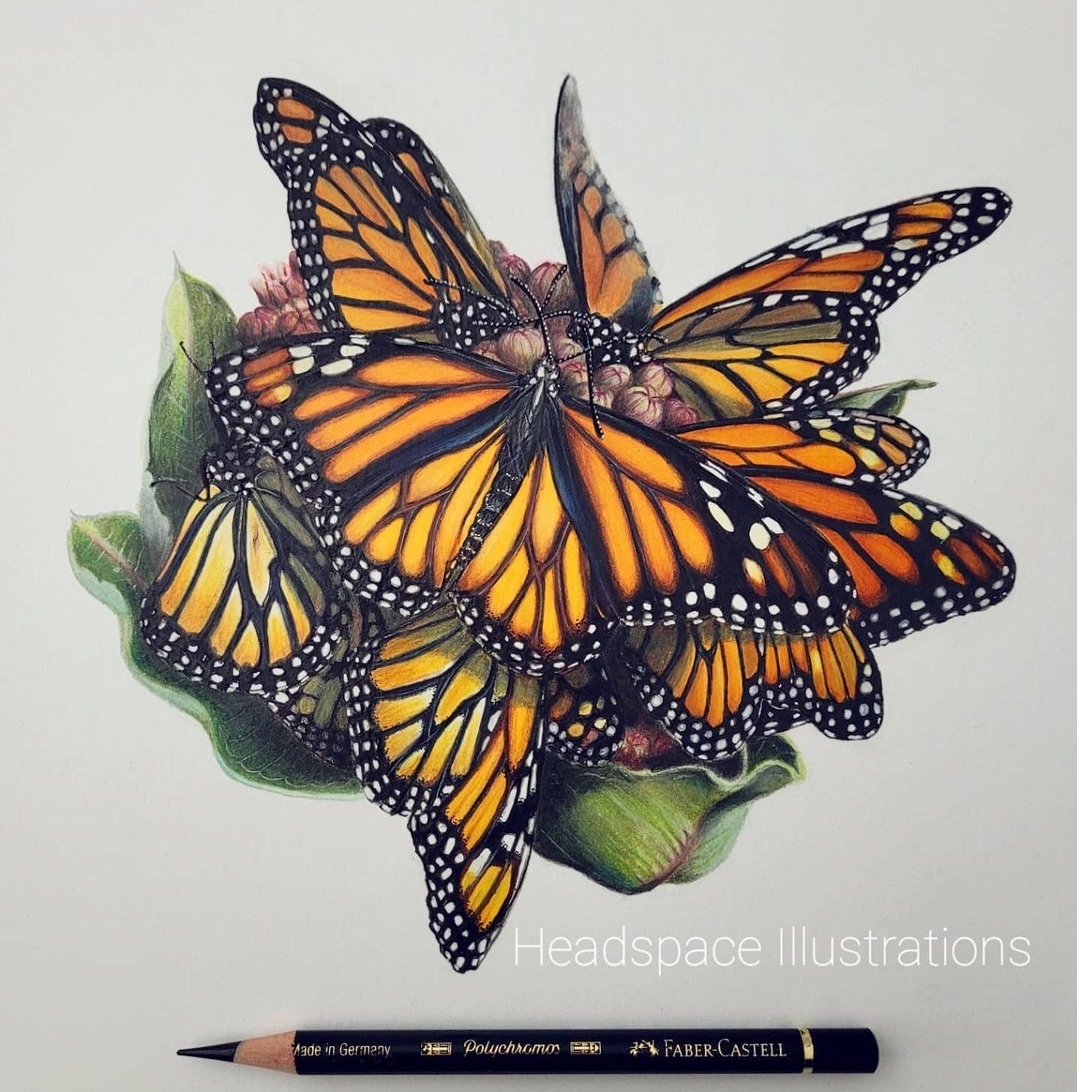Artist Interview – Amy Hetherington

Who are you and what do you do?
I’m Amy, the colored pencil artist behind Headspace Illustrations. I live on the east coast of Canada, with my husband of 23 years and our two beautiful children.

Why do you do what you do?
I’m motivated to continue my journey in artwork for several reasons. From a practical standpoint, it’s a way I can support my family financially while working from my own home studio. Being just a hug away from my young children has been the best decision I could have made. Practicing art has also had a positive effect on my mental health, it’s an exercise in patience, and a quiet moment to reflect on the intricacies of our world around us.
You use so many vibrant colors, do you have any that you favor?
I’m most definitely drawn towards the natural vibrancy found in florals, birds, and gemstones, so it’s difficult to pick a favorite. But going on how short all my green colored pencils are, I probably use them most frequently.


What inspires your art?
We’ve made our home just outside the city, on a spacious wooded lot near the river. Being here is a slower pace of life, where we get to stop and observe in wonderment the flora and fauna around us. During the warmer months, for example, we get up at the crack of dawn to check under our outside light to find hundreds of colorful moths. We hold them in sheer astonishment, take photos, and then release them back into the forest. I’ve illustrated a number of them, and hope to do more.

How and when did you get into art?
After nearly 20 years of no artwork, I stumbled across a colored pencil portrait that sparked in me a strong desire to draw again. Artwork was something I did in high school, and didn’t pick up a pencil again until 2015. I wasn’t overly confident in my abilities, but I decided to take a photo of my little boy’s eye, and try to draw it in graphite. It was exhilarating to see something come alive before my eyes. I wanted to try something in color, and shortly thereafter my husband surprised me with my first set of colored pencils. I haven’t stopped coloring since.

How has your practice changed over time?
When I first started, I illustrated more singular items, but as my confidence grew, I pushed my creativity further into more involved compositions. Although I’ve sustained a similar aesthetic, I’ve improved in details and technique.


What’s your favorite piece of art that you’ve created? Why?
Different projects have specific pieces of my heart in them, in such unique ways that I don’t think I can favor one over the rest. Recently a friend went out of his way to help our family with finishing up a renovation project that was so out of our reach to do. I wanted to show our immense gratitude by illustrating his hand-tied fishing lures. I once surprised my husband with a drawing of our sweet pug that died, which I cried through the entire illustration. Working on commemorative pieces for others is a delicate process, and I feel honored to be asked. Being commissioned to work on a variety of national brands, and seeing that work in stores have been unimaginable experiences. I attach my feelings to each piece and I’m not sure it’s possible to grade one emotion over another.


What’s the best piece of art advice you’ve been given?
Art is not a competition. You are unique, practice your uniqueness. Also, view each piece as an experiment, if it doesn’t turn out as you hoped, it’s okay, it was just an experiment.
What’s one art tip/technique you can share with us that you find really helpful?
Using a marker base or Panpastels as your first layer under colored pencil preserves the tooth of your paper so you can go wild with the rest of your layers.
Do you have any secret tips or techniques you use to salvage a piece when you make a mistake?
I’m quite experienced in having to salvage pieces, all those mistakes, or even just a change of heart, have taught me it is possible to fix. Sometimes the composition needs a creative adjustment. In the case of my Coleman lantern, my marker base bled onto the white background, so I added a piece of rope tied to the handle. Being open-minded and adaptable to the process can result in a more satisfying art piece than you originally thought.


What is your favorite Strathmore paper? Why?
So far, my absolute favorite is Strathmore Mixed Media 400 Series. It checks all the boxes for me. The vellum surface is the perfect amount of texture to grip my pigment, but smooth enough to keep my edges clean and crisp. The thickness can handle heavy-handed coloring, and the pages stay flat. The color is bright white, it’s got easy, tear-away pages, and it’s available from my local, small business, art shop.
That being said, I have yet to do a full illustration on the Strathmore Mixed Media 500 Series. I’ve also just started an illustration on Strathmore Bristol 500 Series, for the first time, and it is DREAMY.

What art materials could you not live without?
A must-have for me is a folding desktop easel. Working upright has corrected my posture and nearly eliminated neck and shoulder pain.

What types of colors are you drawn to for your art and why?
Pink and green, naturally. Those are the colors I surround myself with in my own space, it feels like home.
Who are your biggest influences (or who were when you started doing art)?
MaryJo Hoffman is a professional photographer who sees beauty in the small and simple things she collects on walks. She arranges the pieces with bright white backgrounds, captures them, and aptly calls them her STILL collection. I adore her attention to detail and her generous spirit. She graciously offered her Bluejay wing photo to me to use as a reference, and I couldn’t refuse! She was an inspiration then and still is.

Website/social media links:
Instagram: @headspace.illustrations
Etsy: @headspaceillustrates







